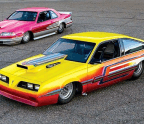E-Turbo Revolution: Electric Turbos Get Real!

We’ve all seen those scam advertisements for the so-called “electric turbo.” These inexpensive devices are claimed to function as turbochargers, but they are really just simple ducted fans or blowers, at best good only for blowing smoke. If you think there’s anything to them, there’s a bridge in Brooklyn I wanna sell you. This is not that article. What you’re about to read about is not your leaf blower or a phony low-cost electric turbo. Instead, we are going to look at the cutting edge of what you might call electrically-assisted turbocharger technology. We’re going to tell you about the revolutionary “e-turbos” perfected on Formula 1 (F1) racing’s V6 MGU-H powerplants and how this now-mature turbo revolution will likely be coming to production cars at your local dealership within the next few years. It’s about the next wave in power-making technology, further fuel economy improvements, and making ever-smaller engines perform as well, or even better than the larger engines they replace. It might be the key for allowing the internal combustion engine to stick around for another generation; and someday, sooner than you think, making unlimited, unrestricted racing engines churn out even more power than they ever had with conventional turbochargers.

“Matching the turbo to the engine has always been a trade-off. A bigger turbo might make more power, but it takes longer to spool it up, so you’d have to compromise to find the right balance. With an electric motor both eliminating lag and controlling boost [on an e-turbo], we can make much more power.”
—Craig Balis, Garrett Motion Senior VP and Chief Technology Officer
Boost, the Replacement for Displacement
Before we get into why an electrically-assisted turbocharger changes everything, let’s take a quick look back on superchargers and turbocharger evolution and the advantages and disadvantages of each. We’ve all heard—I’ve said it myself many a time: “There’s no replacement for displacement.” But actually, there is: add boost via forced induction. Engines make more power with forced induction because it increases the density of air entering the engine by pressurizing or “boosting” it above atmospheric pressure with a supercharger or exhaust-driven turbocharger. The more boost—as measured in psi in the U.S. system or Bars in the ISO system—the more the engine’s power potential. A small engine acts like a bigger engine. And an already large engine acts like, well, a monster.
Superchargers and turbochargers are both air-moving devices. The difference is a supercharger is traditionally driven by the engine crankshaft and a turbocharger by the engine’s exhaust gases. The turbocharger uses exhaust heat and converts it to useful work, spinning a shaft that drives a turbine on the inlet side. The basic
You’re reading a preview, subscribe to read more.
Start your free 30 days





